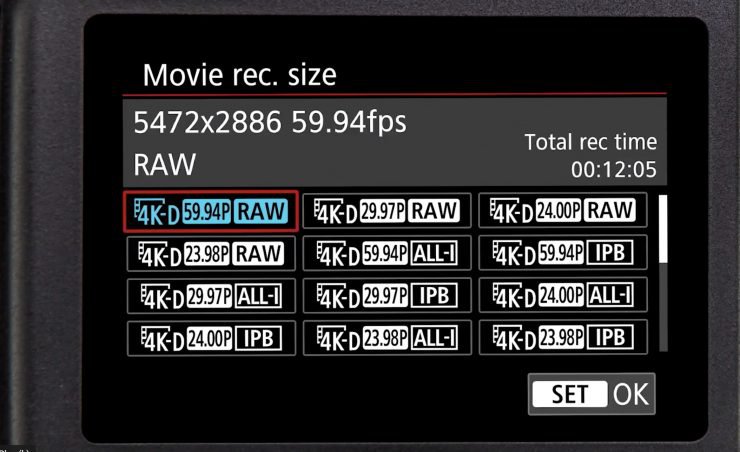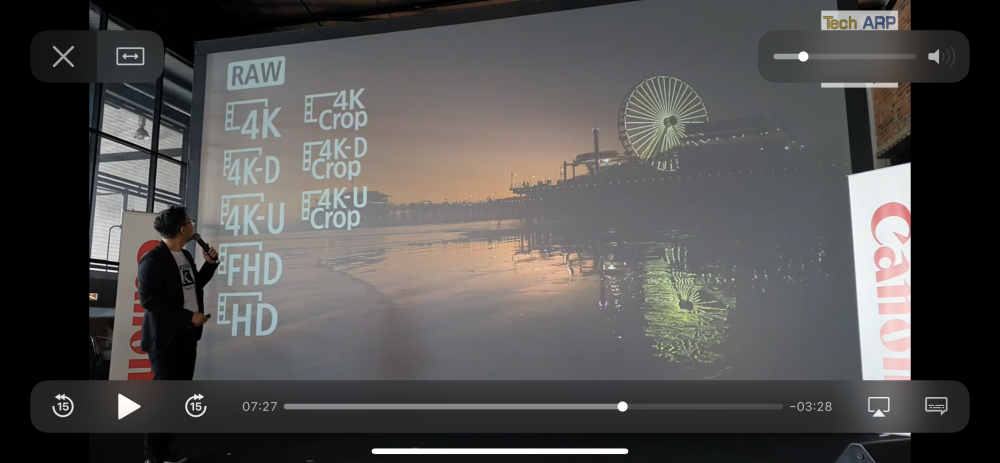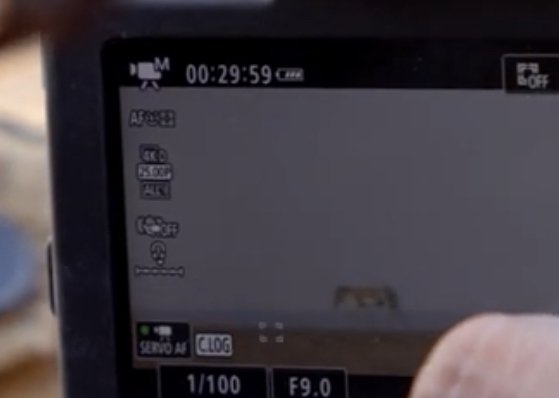
gt3rs
-
Posts
1,092 -
Joined
-
Last visited
Content Type
Profiles
Forums
Articles
Posts posted by gt3rs
-
-
50 minutes ago, MeanRevert said:
Any recommendations for wide, fast lenses to use with this unreleased camera?
I would buy a EF 24 1.4 II or 35 1.4 II used and use with the ND RF-EF adapter
-
9 minutes ago, Rinad Amir said:
I wonder if Gordon shot 100p in 8bit or 10
I hear mix reviews all over the place just have to wait and see it for my self.
I’m talking about the sharpness and is very visible in the posted video. 8 or 10bit would not matter.
-
9 hours ago, Michi said:
EIS does not seem to work as good as on the C500 II. But otherwise it looks like a very impressive camera to me. I do wonder though why there‘s no C-Log 2 and C-Log 3...
I also did notice that is not super stable but it is hard to compare if not using the same focal length,k the same way to carry the camera and also very important the same light situation. Also he does not use the enhanced because he says nothing changes but at least with the M6 II the difference between the two mode is big.
The 5.5 and 4k seem very detailed and looks good.
On the 120fps I'm not so sure is an improvement over the MkII….. if you compare the same pier scene the normal 1080 with the 1080 120fps there is a very visible drop in quality. Not unexpected but I do not agree to his comment that the 120fps is great. Still probably one of the best FF 120fps but for sure not great. -
-
2 hours ago, Dunjoye said:
Beautiful colors as expected. But doesn't have that 1dc mojo. Something about the video form that camera man. I cant explian it.
4k 60fps..... instead of 24fps....
-
12 minutes ago, Avenger 2.0 said:
Good day to sell your Canon EOS 1D MKIII btw. Just had someone drive to me from the other side of the country and saw him search 10 minutes for the movie record function before I delivered the bad news...
😁
-
17 hours ago, Vision said:
Any test footage we can play around? if was posted early i missed it 😞
On YouTube there a re few but no out of camera clog or raw to download yet
-
Seems, at least for photo, at low ISO DR has improved quite a bit compared to Mk II, basically on pair with the A7R IV (1/3 stop worse at ISO 100, 1/3 stop better at ISO 200)
http://www.photonstophotos.net/Charts/PDR.htm#Canon EOS 1D X Mark II,Canon EOS 1D X Mark III,Sony ILCE-7RM4 -
14 minutes ago, Django said:
Total click-bait for sure.. I love how he states to never believe rumors, only to proceed to full speculation moments later!
he does raise a somewhat semi-valid suspicion I guess about the possibility of MJPEG for 8K:
From a video perspective, the camera’s 8K video capture capability will prepare videographers for the future of movie-making- capturing 8K footage today allows for even higher-quality 4K productions in addition to the ability to extract high-resolution still images from the video footage.
To my knowledge only the 1DX2 & 5D4 had a stills extract from video feature and both those cams used MJPEG.
The thought alone of that codec returning gives me the shivers and it would be plain silly for Canon to place such an inefficient codec for such high resolution video files. But who knows.. when Canon introduced 4K on the 1DC it did have that one caveat!
No worry 1Dx III also has the image extractor (from the official manual):
-
Finally got the insta360 One R
Tested quickly yesterday on a skiing session. Here some observation compared to the One X that I have since a year:
+ Gopro swivel mount is great on action cam especially in case of impact as it tend to lose and not break like the tripod mount of the One X. I wish it would be like the Max that the "wings" are part of the body and you don't need a frame.
+ Water proof without the stupid venture case is good, no more crappy stitching or strange vignetting while using it in snow or water.
+ Screen is small but visible in daylight and quite intuitive to use
+ You can use apple watch to control it and to get the GPS stats, I find the phone not ideal while doing sports.... much prefer the watch as remote. I wish it had GPS in the camera itself like gopros
+ battery seems to last longer
+ Phone app is better you can edit without copying the file first so you save space and you can have a quicker turnaround
-+ with the frame and swivel is noticeable heavier that the One X but the shape is better for helm mounting, rollbars, handlebars, etc...
- USB C, MicroSD card door is quite cheap and hard to use while inside the frame
- Construction seems less polished than the One X
- 25 fps not yet available
Video quality is exactly the same as the One X nothing more nothing less.
Did not test yet the 4k mod (seems very similar to a Hero 8 so not a bad option to have) but with the advantage that you can enable and disable FOV and more important stabilization in post.
Did not order yet the 1 inch as you cannot find it nowhere
Bottom-line if you use the One X as action cam then this is quite a big upgrade if not then is not worth the upgrade cost. My One X is on sale and I keep this one.
-
1 hour ago, Miklos Nemeth said:
Still it is just a kind of rumor, even the Canon EOS 1D X Mark III is not available, it was announced to be available mid February 2020, actually now, and I'm definitely looking forward to hands-on evaluation by reviewers like AR, here. As for how the heck Canon could make a 8K video camera while the S1H cannot? The only explanation I can think of is that all recent 24M cameras, A7III, Z6, S1, S1H, fp, all use basically the same Sony sensor (technology), and somehow Canon managed to make a sensor that is revolutionary and better in this regard than the Sony sensor technology. It could be just by-mistake or whatever.
Some users just got the 1Dx III so is shipping, probably in small quantities, but a few people have it already.
-
Random guesses taking the 1Dx III tech on a R5:
data flow for 5.5k 60fps is similar to 8k 30 fps so in theory with CFexpress it could do it in RAW. Not sure what is more limiting for DPAF the data volume or the frame rate.... so not sure it will have DPAF in 8k.
5.5k 60fps is super sampled to 4k 60fps, so again it would be possible to take 8k 30fps and supersampled to 4k 30fps h265 10bit Clog but again would it have DPAF?
Now FF 4k 60fps super sampled is probably unrealistic. Probably a 1:1 crop maybe with DPAF
4k 120fps IMO only possible either line skipping or 1:1 crop.
Best case by guessing:8k 30fps RAW at same data rate that the 5.5k RAW 60 fps of the 1Dx III but with DPAF
FF supersampled 4k 30fps 10 bit h265 CLog with DPAF
4k 60fps or maybe even 120fps 1:1 pixel so 2x crop. 60fps with DPAF
Let see how far they are pushing it..... maybe a big disappointment or maybe another all in like the 1Dx III.....
-
3 minutes ago, Michi said:
None of the japanese companies ever implemented ProRes in a DSLR or mirrorless camera. And nothing indicates this will change with the R5.Would it be nice? Sure!
But sometimes you have to ask where such strange expectations come from. At least they‘re not based on any logical assumption or reality.
Yep unrealistic expectation if you count that even the C200, C300 II and C500 II do not have prores...
-
I should receive my One R this week, the 360 module does not seems any better than the One X that I have, but the waterproof and the screen is a good upgrade for me as the venturecase is a piece of c.... so I will sell the One X as I used a lot in the snow and water.
The 360 reframe quality is not yet ready for prime time but is so good to reframe in post that for certain type of action is unbeatable.
The 1 inch module seems a good step up from the hero 8 and similar. One cool thing is that you can enable or disable the stabilization and the fov in post..... the hero 8 is already processed so if you set the wrong one or you don't know if is better with what level of stabilization you are toasted…. I was shooting last week some rally cars with some hero 8s and when I wanted the hypersmooth on I had it off and vice versa….
-
Cool would be that the R6 as the same sensor as the 1Dx III and at least 4k 30fps with DPAF FF and 4k 1.3 crop 60 fps with DPAF all 10bit 4:2:2 then I have my A (1dx) and B (R6) cam...….. the R5 with all these mpixels smell fishy for video if Canon did not get some breakthrough in sensor technology....
-
Canon EOS R6
In: Cameras
People are a bit too optimistic.... if the R6 will use the 1Dx III sensor, as it could be view that it has the same mpixels and same 20 fps in electronic mode, in a cheaper model it will probably be 4k 30fps FF and 4k 60 fps 1.3 crop hopefully at 10 bit 4:2:2. Question is if FF is super sampled or not. If no CFExpress then no RAW for sure.
-
6 hours ago, scotchtape said:
I didn't mention any of those things but ok. #triggeredcanonfan?
You are saying that 1dx is crippled with questionable features.... like the dpaf in FF, like many others in this forum, there are 3 threads with multiple posts similar to yours saying that Canon is crippling dpaf in ff without realizing that nobody else has ever have made Raw ff with af.... so your post was good info contains?
-
-
1 minute ago, scotchtape said:
How anyone can think that Canon will not cripple their cameras is beyond me.
Even the 1DXIII has questionable PDAF in full frame modes, not to mention no IS in RAW and... NO 24P at launch...
I'll believe it when I see it.
O boy again.... point wich camera can do >4k FF Raw with AF?
I help you: C700 FF (but only with additional recoding module), C500 II and then 1Dx III.... not really questionable as no other manufacturer has a FF camera that can do it. FF Internal Raw 4k or above with AF no other camera so why people continue to complain?
-
44 minutes ago, Mokara said:
Umm....no. 8K at 30 is more data than 5.5k at 60. Do the math.
And remember, this will be in a smaller body that is going to provide less cooling, which means that the camera will do less than the 1D even if it used the same processor.
Not sure what exactly the Digic X is, it may be the sibling of the DV7, meaning it is essentially a Digic 9. Or it may be a processor dedicated to the 1D series, with Digic 9 coming in for the consumer models. If so, then use the E500II as a guide for max specs (in the EOS-R they will be substantially less because of the form factors thermal envelope)
I did a quick mental guess, doing the right math is true that 8k is more by ca 4% than 5.5k 60fps so still doable but I doubt in a R model right now
5.5k 1dx 5496 x 2904 x 60 = 957'623'040
8k 7680 × 4320 x 30 = 995'328'000
-
Not totally impossible as 8K at 30 is less data than 5.5K at 60 and 4k at 120fps could be a 100% crop. Also 45Mpixel at 20 fps... seems fishy but maybe a crop burst like the M6 Ii...
To me it seems all too good to be true
-
2 hours ago, Trankilstef said:
So i tested the Canon 1dx mkIII today and i briefly put it in 4k RAW 25p to test if the dpaf would work. Short answer is it works like a charm. I didn't have lot of time to test other framerates and resolutions but I then asked a Canon rep about it and he said that it works in raw until 30p then it's not possible.
Note aside, the autofocus in video seems to be improved again, it's impressive. Rack focus is very natural, face/eye detection works near flawlessly... I'm very impressed.
You mean RAW so 5.5k not 4k right as there is no 4k RAW...
-
-
On 1/23/2020 at 2:17 PM, independent said:
Any confirmation on rolling shutter?
Apparently FF around 1/60 so 16ms the minimum to be able to do 60fps







Canon EOS R5 8K monster official topic
In: Cameras
Posted
For photo is an amazing lens, I did try it out. for 1h and I found it impressive. For video the problem is the weight and the extending while zooming that could be an issue on gimbals.